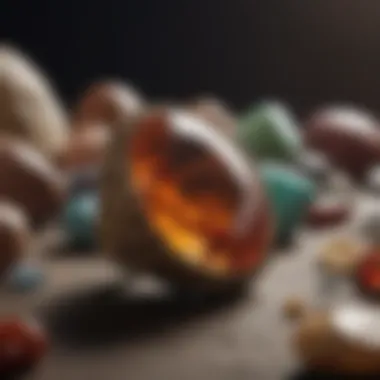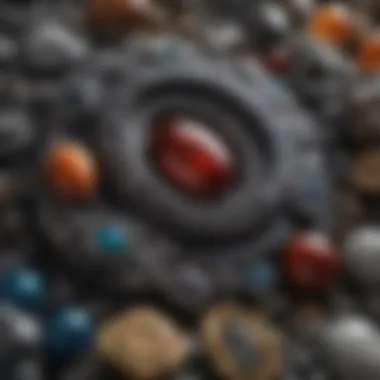Mastering the Craft: A Comprehensive Guide to Creating Stone Jewelry


Rock and Fossil Identification
When venturing into the realm of stone jewelry creation, the first essential step is rock and fossil identification. Understanding the distinct types of rocks and fossils is fundamental in selecting the perfect materials for your jewelry pieces. It entails delving into the unique characteristics that set each type apart. The adept use of specialized tools for identification aids in this meticulous process, enhancing accuracy and precision in stone selection.
Collecting Tips and Techniques
Embarking on a journey to collect rocks and fossils demands adherence to best practices. Implementing proper techniques ensures the preservation of specimens and fosters a sustainable approach to collecting. Pinpointing prime collecting sites is a skill honed through experience and research, offering enthusiasts the opportunity to uncover hidden gems. Moreover, mastering the art of safely extracting specimens from their natural habitat is crucial to preserving their integrity.
Preservation and Display
Preservation plays a pivotal role in extending the longevity of rocks and fossils, safeguarding their intrinsic beauty for generations to come. Employing specialized techniques ensures the integrity of these delicate specimens. Understanding proper storage methods is key in preventing degradation and maintaining the pristine condition of collections. Exploring creative display ideas provides enthusiasts with the opportunity to showcase their treasures in a captivating manner.
Geological Insights
Delving deeper into the world of stone jewelry unveils fascinating geological insights. Exploring the origins of geological formations and the intricate processes that shape them sheds light on the evolution of Earth's landscape. Unraveling the historical significance attached to rocks and fossils offers a glimpse into the past, connecting enthusiasts with ancient narratives. Discovering notable discoveries in the field ignites a sense of wonder and appreciation for the rich tapestry of geological history.
Introduction
In the realm of jewelry craftsmanship lies a sophisticated art form that resonates with enthusiasts and connoisseurs alike - the meticulous creation of stone jewelry. This comprehensive guide delves deep into the nuanced process of bringing these earthly wonders to life. From the initial spark of inspiration to the final polished masterpiece, each step is a testament to the dedication and creativity required in this specialized craft. For rock and fossil collectors exploring the world of stone jewelry, this guide offers a wealth of insight and expertise to elevate their understanding and appreciation.
Understanding the Appeal of Stone Jewelry
Connection to Nature
The allure of stone jewelry lies in its inherent connection to the natural world. Each stone, with its unique color and texture, tells a story of centuries-old geological processes. The integration of natural elements into jewelry pieces imbues them with a sense of timelessness and environmental harmony. For aficionados who seek to embrace nature's beauty in their adornments, stone jewelry represents a conscious choice that goes beyond mere fashion trends.
Unique Aesthetic
The essence of stone jewelry's allure can be attributed to its distinctive aesthetic appeal. Unlike mass-produced accessories, stone jewelry exudes individuality and character. The variations in color, pattern, and mineral composition in different stones ensure that each piece is one-of-a-kind. This exclusivity appeals to collectors who value personalized adornments that reflect their taste and personality.
Historical Significance
Beyond their visual charm, stone jewelry pieces carry a rich historical significance. Throughout centuries, various cultures have revered stones for their perceived healing properties, spiritual significance, and symbolic meanings. Incorporating stones with historical importance into jewelry designs adds layers of depth and storytelling to the wearer, connecting them to age-old traditions and beliefs.
Importance of Stone Selection
Types of Stones


The selection of stones plays a pivotal role in determining the aesthetic and energetic qualities of the final jewelry piece. From the mesmerizing hues of lapis lazuli to the grounding properties of hematite, each type of stone brings its own distinctive charm to the design. Understanding the geological origins and metaphysical properties of different stones empowers designers to create pieces that resonate with both the wearer's style preferences and elemental energies.
Quality Considerations
In the realm of stone jewelry, quality is paramount. The durability, clarity, and brilliance of a stone directly impact the overall visual appeal and longevity of the jewelry piece. By meticulously scrutinizing the quality of each stone used, artisans uphold standards of excellence that ensure the creation of lasting heirlooms beloved by generations.
Symbolism in Stones
Stones have long been revered for their symbolic meanings and mystical associations. From the regal opulence of amethyst symbolizing spiritual wisdom to the protective energy of obsidian guarding against negativity, the symbolism embedded in stones adds profound layers of significance to jewelry designs. By incorporating stones with symbolic resonance, artisans infuse their creations with deeper meanings that resonate with the wearer on a personal and spiritual level.
Tools and Materials
When delving into the art of making stone jewelry, understanding the significance of tools and materials becomes paramount. Without the appropriate instruments and resources, the craftsmanship involved in creating exquisite pieces of stone jewelry would be challenging, if not impossible. Tools play a crucial role in every stage of the jewelry-making process, from selecting the right stones to shaping and polishing them to perfection.
Essential Tools for Stone Jewelry Making
In the realm of stone jewelry making, the selection of tools holds immense importance. Each tool contributes uniquely to the final outcome of the jewelry piece, ensuring precision and quality in every step of the crafting process.
Cutting Equipment
Cutting equipment stands as a cornerstone in the stone jewelry making process. Its precise nature enables artisans to shape raw stones into intricate designs with meticulous accuracy. The key characteristic of cutting equipment lies in its ability to slice through various types of stones, allowing artisans to create custom shapes and sizes. This aspect is especially beneficial as it grants creators the freedom to unleash their artistic visions with detailed precision. While the unique feature of cutting equipment lies in its sharp blades and sturdy construction, providing both efficiency and durability, its disadvantage may lie in the complexity of mastering its technique, requiring skill and practice to handle with finesse.
Shaping Tools
Shaping tools, another essential component, aid in fine-tuning the raw stones into the desired forms for jewelry pieces. The key characteristic of shaping tools is their versatility in creating curves, angles, and textures on the stones, allowing artisans to add depth and dimension to their creations. The benefit of using shaping tools lies in their ability to sculpt stones with precision, bringing out intricate details in the design. The unique feature of shaping tools is their ergonomic design, facilitating comfortable handling during long hours of crafting. However, a potential disadvantage may arise from the need for occasional maintenance to ensure consistent performance.
Polishing Supplies
Polishing supplies play a vital role in bringing out the luster and shine in stone jewelry pieces. The key characteristic of polishing supplies is their ability to refine the surface of stones, enhancing their aesthetic appeal and visual impact. The benefit of using polishing supplies is evident in the final gleam that transforms raw stones into polished gems. The unique feature of polishing supplies lies in their varied compositions, offering different finishes from matte to high gloss. However, a possible disadvantage may stem from the need for careful application to avoid over-polishing and potential damage to the stone's surface.
Crafting Process
In the realm of creating stone jewelry, the Crafting Process stands as a pivotal stage where raw materials transform into exquisite pieces of wearable art. This article meticulously dissects the nuances of the Crafting Process, delving into every intricate step that culminates in the creation of captivating stone jewelry. Ensuring meticulous attention to detail, this section shines a light on the essential elements, benefits, and considerations that elevate the craft to an art form. From selecting the finest stones to meticulous assembly, the Crafting Process serves as the heart of stone jewelry making, where creativity meets precision in a harmonious dance.
Preparing the Stones
When it comes to Crafting Stone Jewelry, preparing the stones is a crucial initial step that sets the foundation for the entire creative journey. Within this phase, the meticulous processes of Cleaning and Inspecting, Cutting Techniques, and Shaping Considerations play a significant role. Each aspect is meticulously honed to ensure that the stones are not only visually stunning but also structurally sound, paving the way for enduring and exquisite jewelry pieces that stand the test of time. Through careful consideration of these elements, stone jewelry artisans can unleash the true potential of each stone and create unique works of wearable art that resonate with the soul.
Cleaning and Inspecting


Cutting Techniques
Shaping Considerations
Assembling the Jewelry Pieces
The assembly phase in Crafting Stone Jewelry holds a special place as it is where the individual elements come together to form a cohesive and captivating piece. Within this stage, crucial tasks such as Setting Stones, Adding Details, and Ensuring Durability take center stage. Each task is meticulously executed to ensure that the final piece not only showcases the beauty of the stones but also exhibits impeccable craftsmanship and durability. By paying close attention to these aspects, artisans can create jewelry pieces that not only dazzle the eyes but also stand the test of time, becoming cherished heirlooms for generations to come.
Setting Stones
Adding Details
Ensuring Durability
Finishing Touches
In the realm of crafting stone jewelry, the phase of finishing touches holds paramount significance, serving as the ultimate detail that elevates a piece from good to exceptional. These final touches encompass the polishing and refining processes, which are pivotal in achieving the desired luster and quality in the end product. By dedicating meticulous attention to detail during this stage, artisans can bring out the inherent beauty of the stones used, ensuring a flawless and exquisite outcome. The meticulous application of polishing techniques and surface finishes not only enhances the visual appeal of the jewelry but also adds a layer of sophistication and finesse.
Polishing and Refining
When it comes to perfecting stone jewelry, the technique of shine plays a crucial role in creating a captivating and alluring appearance. Techniques for shine involve a careful balance of precision and expertise, aiming to highlight the natural characteristics and colors of the stones. By implementing the right polishing methods, artisans can achieve a brilliant sheen that reflects light elegantly, enhancing the overall aesthetics of the jewelry pieces. The choice of suitable shine techniques is imperative in achieving a polished finish that exudes elegance and refinement.
Surface finishes further contribute to the allure of stone jewelry, adding a layer of sophistication and style. The meticulous application of surface finishes not only enhances the visual appeal of the stones but also provides a protective layer that ensures durability. By selecting appropriate surface finishes, artisans can achieve a range of textures and effects, from sleek and glossy to matte and understated. Each type of finish brings its own unique charm to the jewelry, allowing for customization and personalization according to the desired aesthetic.
Quality Control and Final Inspection
In the domain of stone jewelry crafting, quality control and final inspection are indispensable stages that ensure the integrity and excellence of the final pieces. Checking for flaws involves a meticulous assessment of each component, identifying any imperfections that may detract from the overall quality. This rigorous inspection process allows artisans to address any issues promptly, maintaining the standard of craftsmanship expected in artisanal jewelry. By conducting thorough quality checks, artisans can uphold their reputation for producing impeccable and flawless pieces.
Adjustments if needed serve as the final step in the crafting process, offering artisans the opportunity to refine and perfect their creations. This stage enables artisans to rectify any identified flaws or imperfections, ensuring that the finished jewelry meets the highest standards of quality. Through precise adjustments and fine-tuning, artisans can elevate their pieces to a level of excellence that surpasses expectations, delivering exquisite stone jewelry that captivates the senses and stands the test of time.
Artistic Considerations
In the multifaceted realm of creating stone jewelry, artistry plays a pivotal role, elevating pieces from mere accessories to exquisite works of wearable art. Artistic considerations encompass a spectrum of elements that breathe life and character into each creation, catering to the connoisseurs seeking a harmonious fusion of creativity and craftsmanship. The significance of artistic considerations in this article lies in unraveling the nuances of design that underscore the essence of stone jewelry. Enthusiasts embarking on their jewelry-making journey are beckoned to delve into the diverse facets of color combinations, texture variations, and shapes & forms, mastering the art of infusing stones with individuality and soul.
Design Elements in Stone Jewelry
Color Combinations
Color combinations wield a masterful influence in the landscape of stone jewelry, dictating the visual impact and emotive resonance of each piece. The interplay of hues harmonizes or contrasts, creating dynamic narratives within the confines of a single adornment. In this guide, color combinations stand as the cornerstone of expression, with each palette choice conveying a distinct mood and aesthetic language. The strategic selection of colors transforms raw materials into captivating compositions, amplifying the allure of the stones and instilling them with a captivating vibrancy that speaks to the discerning wearer.


Texture Variations
Texture variations add a tactile dimension to stone jewelry, engaging not just the eyes but also the sense of touch in a symphony of sensory delight. Within this narrative, texture becomes a silent protagonist, enriching the visual narrative with depth and character. In the crafting process outlined by this guide, texture variations are harnessed as tools of intrigue, allowing for the creation of pieces that invite closer inspection and evoke tactile appreciation. The unique surface qualities of each stone are highlighted through meticulous craftsmanship, enhancing the overall appeal of the jewelry and offering a sensory journey to the wearer.
Shapes and Forms
Shapes and forms in stone jewelry serve as the architectural blueprints that manifest the designer's vision into tangible beauty. Each contour and silhouette is deliberate, contributing to the aesthetic harmony of the piece while reflecting broader artistic influences. Within this article's narrative, shapes and forms emerge as vessels of creative expression, sculpting the raw materials into wearable art that transcends mere adornment. The exploration of shapes and forms fosters a dialogue between tradition and innovation, enriching the jewelry landscape with pieces that both honor heritage and embrace contemporary design sensibilities.
Incorporating Personal Style
Personal style is the hallmark of individuality in stone jewelry, infusing each creation with the essence of the maker's identity and vision. The act of customization empowers enthusiasts to imprint their unique signature onto their pieces, shaping not just the outward appearance but also the intrinsic narrative woven into the jewelry. Within the context of this article, incorporating personal style is positioned as a transformative process, catalyzing the evolution of raw materials into personalized artifacts of self-expression.
Customization Options
Customization options in stone jewelry embolden creators to tailor their pieces to specific preferences, steering the design narrative towards personalized manifestations of beauty. The inclusion of customizable elements grants freedom of expression, inviting enthusiasts to experiment with layouts, motifs, and embellishments that resonate with their aesthetic sensibilities. In this comprehensive guide, customization options emerge as gateways to innovation, offering a palette of choices that enable the realization of bespoke designs reflective of individual taste and style.
Signature Touches
Signature touches epitomize the essence of personal branding in stone jewelry, encapsulating the maker's identity within subtle yet resonant details. From unique clasps to engraved insignias, these signature touches serve as hallmarks of authenticity and artistry. Positioned within the scope of this article, signature touches are celebrated as intimate imprints that not only authenticate the piece but also imbue it with a narrative thread connecting creator and wearer. The integration of signature touches adds a layer of exclusivity and prestige to the jewelry, elevating each creation into a distinct emblem of craftsmanship and personal style.
Marketing and Presentation
In the realm of stone jewelry crafting, Marketing and Presentation play a pivotal role in showcasing the allure and uniqueness of each piece. Effective marketing strategies are essential for reaching the discerning audience of rock and fossil collectors, creating a distinct brand identity, and driving sales. Presentation, on the other hand, involves visually capturing the essence of the stones used, the craftsmanship involved, and the overall aesthetic appeal of the jewelry pieces. It is through strategic marketing and compelling presentation that stone jewelry makers can elevate their creations to new heights and attract a wider audience.
Photography and Branding
Showcasing the Pieces
When it comes to showcasing stone jewelry pieces, photography takes center stage as a powerful tool for capturing the intricate details, colors, and textures of the stones. High-quality images that highlight the unique features of each piece not only attract potential customers but also convey the artistry and craftsmanship involved. Vibrant photographs showcasing the jewelry from different angles help customers appreciate the beauty and intricacy of the designs, enticing them to make a purchase. Utilizing professional lighting techniques and settings enhances the visual appeal, effectively drawing attention to the exquisite nature of the stone jewelry.
Creating a Brand Identity
Developing a strong brand identity is crucial for establishing credibility and recognition in the competitive world of stone jewelry making. Branding goes beyond just a logo; it encompasses the values, storytelling, and unique aspects that set a jeweler apart from others. By defining a brand voice, visual elements, and consistent messaging, stone jewelry makers can cultivate a distinct identity that resonates with their target audience. A well-defined brand identity not only fosters trust and loyalty but also differentiates the jewelry maker in a saturated market, making their pieces memorable and sought after.
Online Platforms and Sales
In today's digital age, online platforms and e-commerce strategies are essential for reaching a global audience of rock and fossil collectors. Establishing a strong online presence through websites, e-commerce platforms, and social media channels allows stone jewelry makers to showcase their creations to a vast clientele. By leveraging e-commerce strategies, such as seamless navigation, secure transactions, and personalized customer experiences, jewelers can boost sales and enhance customer satisfaction. Engaging with customers on online platforms creates a personalized shopping experience, where queries can be addressed, feedback can be obtained, and a sense of community among collectors can be fostered.
E-commerce Strategies
A successful e-commerce strategy involves creating user-friendly websites, optimizing product listings with detailed descriptions and high-quality images, and providing secure payment gateways for seamless transactions. Offering various payment options, exclusive discounts, and prompt customer support further enhances the online shopping experience, encouraging repeat business and positive word-of-mouth referrals. By continuously refining e-commerce strategies based on market trends and customer feedback, stone jewelry makers can adapt to the evolving digital landscape and stay ahead of the competition.
Engaging with Customers
Engagement with customers is integral to building lasting relationships and fostering brand loyalty in the realm of stone jewelry making. Active interaction on social media platforms, prompt responses to inquiries, and personalized communication create a sense of connection between the jeweler and the customer. Segmented email campaigns, virtual jewelry showcases, and interactive live sessions further engage customers, providing them with a more immersive and personalized shopping experience. By actively listening to customer feedback, addressing concerns promptly, and incorporating customer preferences into new designs, jewelry makers can cultivate a loyal following and enhance their brand visibility in the competitive market.







